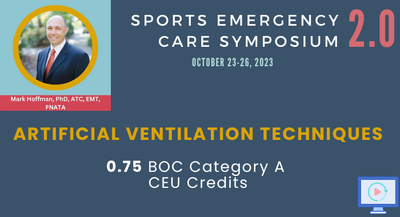General Course Information
Learning Material
Course Info (BOC Domains of Athletic Training; Course Description; Learning Objectives; Clinical Bottom Line; Summary Conclusions)
BOC Domains of Athletic Training:
- Domain II - Examination, Assessment and Diagnosis
-
Domain Ill - Critical Incident Management
- Domain IV - Therapeutic Interventions
Presentation Description:
The focus of this presentation is on the detailed aspects of artificial ventilation techniques, an essential component of sports emergency care. Topics covered include the utilization of oropharyngeal and nasopharyngeal airways, the identification of breathing problems, and guidelines for using supplemental oxygen and positive pressure ventilation, all vital for athlete safety.
Learning Objectives - Upon completion of this course, participants will be able to:
- Describe the uses, cautions, and constraints of airway adjuncts and advanced airways.
- Distinguish between sufficient and insufficient breathing in patients.
- Ascertain situations that call for supplemental oxygen and positive pressure ventilation.
- Understand the physiological contrasts between spontaneous and positive pressure ventilation.
- Review the approaches to artificial ventilation and how to gauge their effectiveness.
Clinical Practice Gap Statement:
In the domain of athletic training, there is a notable gap in the application and understanding of emergency respiratory care. Athletic trainers often encounter obstacles in accurately determining the need for and implementation of artificial ventilation procedures. This leads to compromised care and delays in medical action. Many may also lack the most up-to-date methods and equipment needed for competent airway management, creating an unsafe environment during acute respiratory incidents. This presentation aims to close this gap by imparting the latest clinical best practices.
Clinical Bottom Line Statement:
Being highly skilled in artificial ventilation techniques is not optional but essential for athletic trainers. Such expertise not only entails a deep understanding of respiratory physiology but also enables quick and accurate decision-making during emergencies. Skilled application of these methods helps athletic trainers effectively minimize risk and improve outcomes for athletes. The impact of mastering artificial ventilation can be life-altering in high-stakes situations involving athlete respiratory emergencies.
Summary Conclusion Statements:
- Skillful application of airway adjuncts has a significant influence on the trajectory of an athlete’s medical condition.
- The ability to properly discern the need for supplemental oxygen is a crucial and mandatory skill for modern athletic training.
- A deep understanding of positive pressure ventilation is essential for effective intervention in respiratory emergencies.
- It is imperative for athletic trainers to regularly update their skills and knowledge in artificial ventilation, as it has a direct bearing on athlete safety and outcomes.


